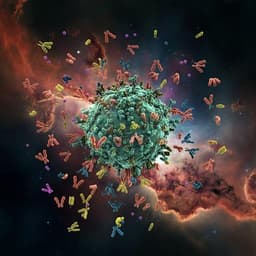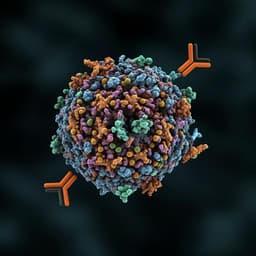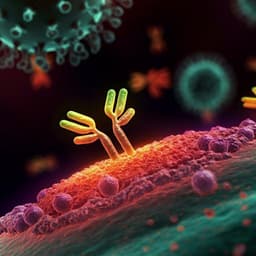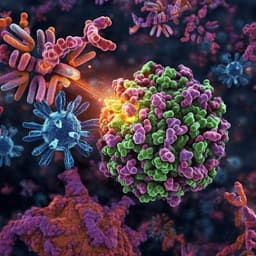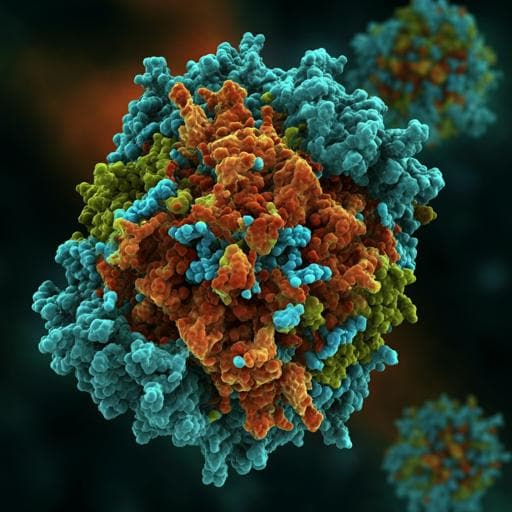
Medicine and Health
Broadly neutralizing antibodies against Omicron-included SARS-CoV-2 variants induced by vaccination
X. Chi, Y. Guo, et al.
Exciting research reveals that the adenovirus-vectored COVID-19 vaccine (Ad5-nCoV) induces broadly neutralizing antibodies against Omicron and other SARS-CoV-2 variants. The study introduces ZWD12, a monoclonal antibody with remarkable potency against these variants, paving the way for new therapeutic mAb drugs and innovative broad-spectrum vaccines. This groundbreaking work was conducted by a talented group of researchers.
~3 min • Beginner • English
Introduction
The COVID-19 pandemic caused by SARS-CoV-2 has led to substantial global morbidity and mortality. Multiple variants of concern (VOCs)—Alpha, Beta, Gamma, Delta, and Omicron—carry mutations in the spike (S) protein, raising concerns about immune escape, reduced vaccine efficacy, and the effectiveness of monoclonal antibody (mAb) therapies. The spike RBD alternates between down and up conformations, with ACE2 binding only to the up state. Neutralizing antibodies (nAbs) targeting RBD are categorized into groups A–F based on epitope and binding mode, with groups E–F recognizing more conserved non-ACE2-overlapping epitopes. Omicron harbors an unusually high number of S mutations and has shown resistance to many approved or clinical-stage mAbs and to vaccine-elicited sera. This study investigates longitudinal antibody responses after prime-boost vaccination with Ad5-nCoV, isolates and characterizes bnAbs able to neutralize VOCs including Omicron, elucidates their binding mechanisms by cryo-EM, and evaluates in vivo protection, addressing the urgent need for bnAbs against evolving variants.
Literature Review
Prior work has shown that VOCs can partially escape neutralization by convalescent or vaccine-induced sera and reduce the efficacy of several therapeutic mAbs. Omicron, in particular, markedly decreases sensitivity to many approved or clinical-stage antibodies (e.g., REGN10933/REGN10987, LY-CoV016/LY-CoV555, AZD1061/AZD8895, BRII-196), while some antibodies like S309 (group E) retain activity with reduced potency. RBD-targeting antibodies are grouped A–F: groups A–D largely overlap the ACE2-binding site and are more impacted by RBD mutations; groups E–F target conserved sites outside ACE2 interface and tend to be less affected. Reports also indicate reduced neutralization of Omicron by two-dose mRNA vaccine plasma, with improved activity after booster doses. These findings establish a landscape of antibody escape and inform the search for bnAbs with conserved epitope recognition.
Methodology
- Human cohort and sampling: Five healthy adults received aerosolized Ad5-nCoV prime and intramuscular boost 3 months later. Plasma and PBMCs were collected before vaccinations, at 1 and 6 months post-prime, and at 0.5, 1, 3, and 6 months post-boost. PBMCs were isolated by Ficoll gradient.
- Serology and neutralization: ELISAs measured IgG/IgA binding EC50 against S proteins/fragments (S1, S2, NTD, RBD) of multiple SARS-CoV-2 variants. Pseudovirus neutralization used HIV-based luciferase reporter pseudotypes bearing spike from Wuhan-Hu-1 and VOCs (Alpha, Beta, Gamma, Kappa, Delta, Omicron) to determine IC50. Authentic virus neutralization used microneutralization for Wuhan-Hu-1, Beta, Delta, and plaque reduction assay for Omicron in BSL-3.
- Single B cell sorting and mAb generation: At 0.5 months post-boost, antigen-specific memory B cells (CD3−CD19+IgG+CD27+ binding to Wuhan-Hu-1 SECD) were sorted as single cells. VH/VL genes were RT-PCR amplified, sequenced, cloned into IgG1 expression vectors, transiently expressed in Expi293F cells, and purified via Protein A.
- BCR repertoire sequencing: 5' RACE and NGS of IgG/IgK/IgL repertoires from PBMC RNA; processed with IgBLAST and the Immcantation toolkit (Change-O, Alakazam, SHazaM) to analyze V(D)J usage, CDR3 length, somatic hypermutation (SHM), and clonotypes across time points.
- Binding kinetics and competition: SPR measured Kon/Koff/KD for mAbs binding to SECD of Wuhan-Hu-1 and VOCs including Omicron. BLI competition tested epitope binning among isolated mAbs and with controls (REGN10933, REGN10987, S309) and ACE2-blocking ability.
- Cryo-EM structure determination: Purified Delta SECD-6P trimer was complexed with Fabs of ZWD12 or ZWC6, vitrified, and imaged on a Titan Krios with K3 detector. Data were processed in Relion and cryoSPARC with focused refinement on the RBD–Fab interface. Models were built by MDFF and refined in Phenix, enabling epitope mapping.
- In vivo efficacy: K18-hACE2 transgenic mice were challenged intranasally with Delta variant. Prophylactic (3 days pre-challenge) and therapeutic (1 day post-challenge) treatments with ZWD12 (2 or 10 mg/kg) or ZWC6 (10 mg/kg) were administered. Outcomes included survival, body weight, lung viral RNA copies (qRT-PCR), infectious titers (TCID50), and lung histopathology at day 3 post-infection.
Key Findings
- Vaccine-elicited polyclonal responses: Binding IgG increased robustly post-prime and peaked 0.5 months post-boost, then declined but remained detectable at 6 months. Neutralization IC50s against Wuhan-Hu-1, Beta, and Delta pseudoviruses were boosted on average by 5.8-, 4.9-, and 3.8-fold from prime to post-boost. EC50 for SECD-binding IgG increased 3.2-fold from 1 month post-prime to 0.5 months post-boost; IgA EC50 changed by 1.1-fold.
- BCR repertoire dynamics: Post-prime increases in IGHV2, IGHD6, IGHJ5 usage; a preference for IGHV2-5/IGHJ4 combination; minimal heavy-chain CDR3 length of 16.8 aa at 0.5 months post-boost; SHM increased after boost. Light-chain gene usage, SHM, and CDR3 length were relatively stable.
- mAb isolation and specificity: Nineteen SECD-binding mAbs were isolated; 78.9% recognized S1, 15.8% S2. Among anti-S1 mAbs, 80% bound NTD and 53.3% bound RBD. All 19 cross-reacted with Alpha, Beta, Gamma, Kappa, Delta, and Lambda SECD; Omicron SECD binding was largely lost (ZWC6 notably failed to bind).
- Pseudovirus neutralization breadth: Of 19 mAbs, the proportions with IC50 <100,000 ng/mL were Wuhan-Hu-1 52.6%, Alpha 63.2%, Beta 47.4%, Gamma 57.9%, Kappa 42.1%, Delta 52.6%, and Omicron 36.8%.
- Authentic virus neutralization: ZWD12 showed ultrapotent neutralization of Wuhan-Hu-1, Alpha, Beta, Gamma, Kappa, and Delta, outperforming or comparable to EUA mAbs REGN10933 and REGN10987. Against authentic Omicron, ZWD12 retained the highest neutralizing activity with lower IC50 than S309, while ZWC6 and REGN antibodies failed to neutralize.
- Binding kinetics and competition: ZWD12, ZWC12, ZWC10 bound SECD of Wuhan-Hu-1 and VOCs including Omicron with high affinity; ZWC6 and ZWD11 bound poorly to Omicron. BLI showed ZWC6, ZWD12, ZWD11, REGN10987, and S309 formed a competing group; most of these blocked ACE2–S binding except S309. ZWD12 did not compete with S309, implying distinct epitopes.
- Clonotype trajectories: ZWD12 clonotype was detected only at 0.5 and 1 month post-boost; ZWC12 clonotype persisted from 6 months post-prime through 6 months post-boost; a low-affinity nAb (ZWG9) clonotype was present at all seven time points.
- In vivo protection: Prophylactic ZWC6 (10 mg/kg) conferred full survival against lethal Delta challenge, with partial protection therapeutically. ZWD12 at both 10 mg/kg and 2 mg/kg provided complete survival in both prophylactic and therapeutic regimens, significantly reduced lung viral RNA and infectious titers, and ameliorated lung pathology, with stronger effects when given prophylactically.
- Structural basis: Cryo-EM structures of Delta SECD trimer bound to ZWD12 (closed conformation; three Fabs) and ZWC6 (one up and two down RBDs) revealed group D-like binding modes. ZWD12 engages RBD mainly via CDRH3 and CDRL3; its epitope includes residues Asn343, Trp436, Asn437–Asn441, Val445, Pro499, Thr500, Asn501, Val503, Gln506, Tyr508, overlapping minimally with Omicron mutations (only N440K). ZWC6 epitope overlaps Omicron mutations S371L, S373P, S375F, explaining its loss of breadth.
Discussion
This study shows that Ad5-nCoV prime-boost vaccination elicits durable polyclonal responses with boosted neutralization against VOCs, including Omicron. From these responses, the group identified bnAbs, notably ZWD12, with broad and potent neutralization across Alpha, Beta, Gamma, Kappa, Delta, and Omicron. Despite belonging to group D (often more affected by RBD mutations), ZWD12 retained strong activity against Omicron, comparable to or better than S309 (group E), and provided complete protection in a stringent K18-hACE2 mouse challenge model both prophylactically and therapeutically. Structural analyses demonstrate that ZWD12 targets a relatively conserved RBD epitope with minimal overlap with Omicron’s mutation sites, offering a mechanistic explanation for its breadth. These findings address concerns about antibody escape by VOCs and indicate that certain group D epitopes can yield bnAbs resilient to antigenic drift, supporting their development as therapies and as templates for broad-spectrum vaccine design.
Conclusion
Ad5-nCoV vaccination elicits bnAbs that evolve over time, among which ZWD12 exhibits exceptional breadth and potency against major SARS-CoV-2 VOCs, including Omicron, and confers complete protection in vivo. Cryo-EM structures map a conserved RBD epitope targeted by ZWD12 with minimal overlap with Omicron mutations, rationalizing its breadth and highlighting this site as a promising target for next-generation broadly protective vaccines and therapeutic antibody development. Future work should evaluate clinical efficacy and safety of ZWD12, monitor effectiveness against newly emerging variants, and incorporate its epitope into vaccine immunogen design strategies.
Limitations
Related Publications
Explore these studies to deepen your understanding of the subject.



